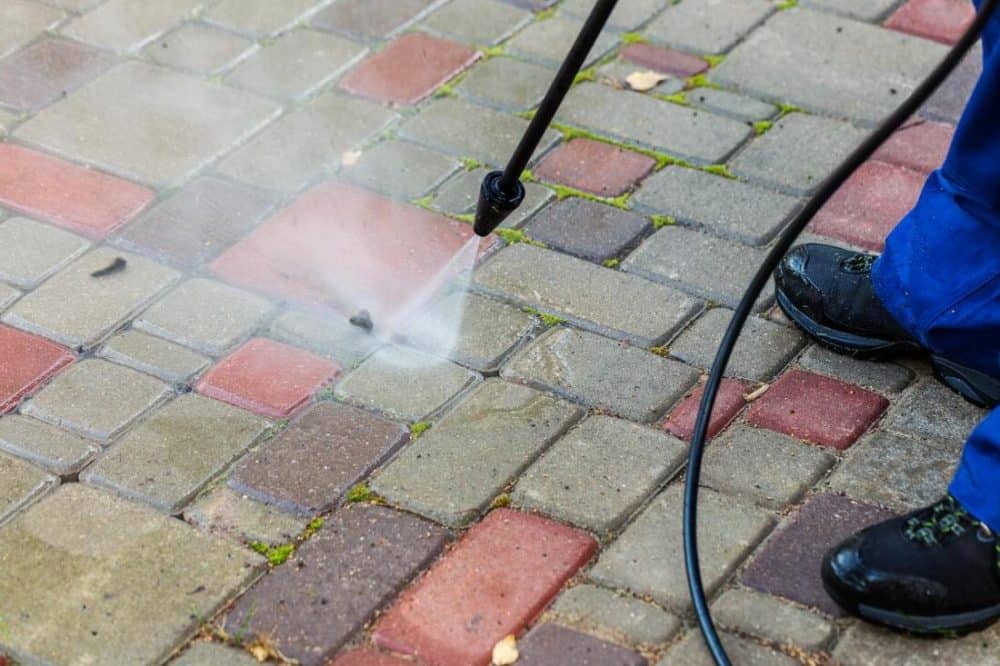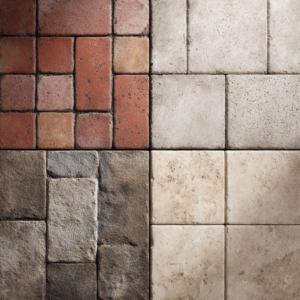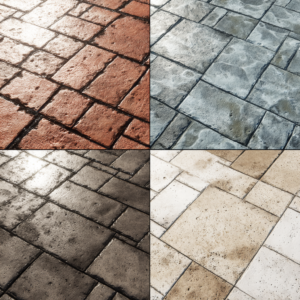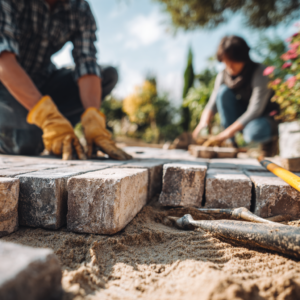If you live in humid climates and are the proud owner of a concrete paver patio, you know very well how frustrating algae can be. They can be a real problem if not dealt with properly and right away. So how exactly should you approach that – how to clean algae from your concrete patio?
There are several ways in which you can remove algae. Some are simpler, some are more chemical and dangerous, and some are even mechanical.
You have a lot of options to choose from, and one of them is sure to leave you satisfied. So let’s present you with these options right away, and then talk a little more about how algae forms and the importance of removing them.
Jump to:
How to clean algae from a concrete patio

Method 01: Boiling water
Let’s start simple, with something that everyone has a home and completely non-chemical.
Fill a bucket with boiling water and carefully pour in the area. Then take some form of stiff brush and start scrubbing the area. Be careful with that technique if you are working with polished pavers prone to scratches. In that case, you want to use a soft brush and be as gentle as possible.
Once that is done, you can hose the area to wash away the debris.
Method 02: Drying and heating the area
Algae thrive in humidity and shadow. If there’s any way you can expose your patio to sunlight, that is the best remedy you can ask for.
However, we are all aware that sometimes exposure to the sun is out of our hands. In that case, we recommend you use a heater, a big fan, or a leaf blower.
If the area becomes dry enough, magically, the algae almost come out on its own. So all you have to do is use a broom to brush them away.
Method 03: Pressure washer
If the previous methods didn’t work, now we are starting to move into the resistant algae territory. A pressure washer is an excellent way to clean algae, given you can dry your area well later. But be careful with pressure washers – they can damage your pavers if not handled properly.
If this is your first time using one, start with the lowest possible psi configuration and from a safe distance. Increase the psi or close the distance until you see it affect the algae, but find that sweet spot little by little.
Method 04: Commercial products
Time to bring the big guns and buy a specialized concrete cleaning product. In the worst of cases, you’ll have to buy a mold stain remover.
Simply follow the instructions on the label of your product of choice, but most of them will tell you to spray the product on the area and then wait for about 15 minutes before scrubbing and rinsing it away.

Use bleach and vinegar to clean algae from concrete!
On the subject of how to clean algae from a concrete patio, we will often see people saying that bleach and vinegar can be used as a cleaning option.
Although bleach and vinegar can indeed damage the algae, they can also damage the concrete itself, so you can see why we consider that a problem. In a world where you have specialized concrete cleaning concrete and mold cleaning solutions, why risk damaging your pavers with an unreliable method?
Damage to pavers is, sometimes, irreversible. So is never safe to risk staining them for the sake of cleaning them. You don’t want to end up with a bigger problem than you begin with.
We don’t recommend the use of bleach or vinegar – not when there are safer specialized solutions out there.
Types of algae in concrete patios
The most common types of algae found on concrete pavers include:
Green Algae (Chlorophyta)
- Characteristics: Green, slimy, and can form a thin film or thick layer.
- Common Species: Chlorella, Spirogyra.
- Conditions: Thrives in sunlight and moist conditions.
Blue-Green Algae (Cyanobacteria)
- Characteristics: Blue-green color, can appear as a slimy layer or as mats.
- Common Species: Nostoc, Anabaena.
- Conditions: Can survive in extreme conditions, including high temperatures and low light.
Diatoms (Bacillariophyta)
- Characteristics: Brownish color, often forming a thin, slippery layer.
- Common Species: Navicula, Pinnularia.
- Conditions: Prefer moist environments and can be found in shaded areas.
Red Algae (Rhodophyta)
- Characteristics: Red or reddish-brown color, less common on concrete but can occur.
- Common Species: Porphyridium.
- Conditions: Typically found in very moist or aquatic environments.
Yellow-Green Algae (Xanthophyta)
- Characteristics: Yellow-green coloration.
- Common Species: Vaucheria.
- Conditions: Prefers moist, shaded environments.
How to prevent the formation of algae
As we previously mentioned, algae love to grow in humid and shadowy areas.
Your patio either receives sunlight or doesn’t, there’s not a lot we can do about that. We recommend you always think about that during the planning phase of a patio installation, but maybe that ship has already sailed for you.

In that case, the best thing you can do is get rid of the humidity. Start by checking for drainage issues – both in the installation itself and in the structures surrounding it – and avoid the accumulation of furniture and large debris on the pavers. Keep everything as exposed to the sun and air as possible.
That also goes for plant life, by the way. It is nice to have plants around, maybe too many, especially blocking the sun, can do more harm than good.
How to clean algae from concrete patios: get professionals to help you
As you can see, there’s no mystery when dealing with algae. For the simple cases, there are some easy possibilities to clean it. And in the most drastic cases, there are tons of specialized cleaning products in the market you can choose from.
The difficult thing is to identify the causes of an algae problem and fix it. For that, your best course of action is to hire professionals to help you do so.
Professionals in the landscape area can help you identify the problem and give you an outline not only on how to clean algae from a concrete patio but also to fix the problem for good.
And if you happen to be around Sarasota County, FL, why not give us here at JS Brick a call?
For 20 years we have been providing the area with top-quality work in the supply, maintenance, and installation of pavers. Call us anytime at +1 941 586 9140 for a free estimate on our services. We would be happy to hear from you!



